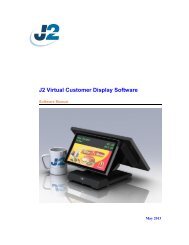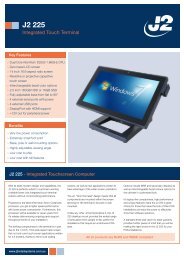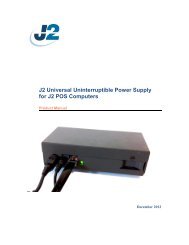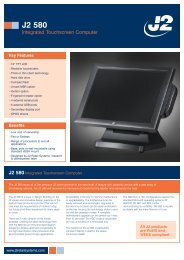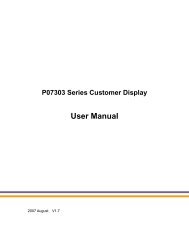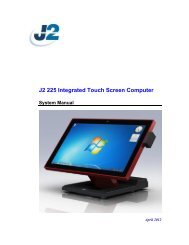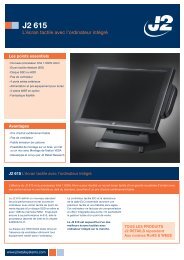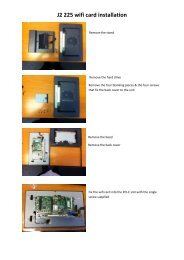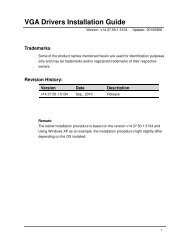J2 680 Integrated Touchscreen Computer System Manual - Size
J2 680 Integrated Touchscreen Computer System Manual - Size
J2 680 Integrated Touchscreen Computer System Manual - Size
Create successful ePaper yourself
Turn your PDF publications into a flip-book with our unique Google optimized e-Paper software.
RAID<br />
RAID Overview<br />
The <strong>680</strong> uses the Intel Matrix Storage Technology to allow the two internal 2.5 inch hard<br />
drives to be configured as a RAID array. The <strong>680</strong> supports RAID 0, RAID 1 and Intel<br />
Matrix RAID which combines the benefits of two RAID volumes in a single RAID array.<br />
If you are not currently familiar with RAID arrays Intel has a good white paper on the<br />
subject at: http://www.intel.com/design/chipsets/applnots/310855.htm<br />
There are a number of benefits to using the RAID feature.<br />
Protection is one benefit. When using a RAID 1 array, data is protected by mirroring.<br />
The primary RAID volume is duplicated automatically on the second drive, a mirror<br />
image of the first. If one of the two hard drives fails the system will still keep working.<br />
The bad hard drive can be replaced while the system is running. This is called hot<br />
swapping or hot plug. The new drive will automatically be updated to a mirror image of<br />
the working drive.<br />
Performance is another feature RAID can provide. When configured as a RAID 0 array<br />
the two drives in the RAID array are striped. With striping, data is split between two<br />
drives. This allows the <strong>680</strong> to read the data more than twice as fast as with a single drive.<br />
The performance can be more than twice as fast because the Intel RAID driver also uses<br />
the AHCI NCQ function built into the SATA drives.<br />
Protection and Performance can be mixed using an Intel Matrix RAID configuration,<br />
whereby a RAID 1 and RAID 0 can be setup on the same RAID array. Mission critical<br />
data can be stored in the RAID 1 volume and data requiring performance can be stored on<br />
the RAID 0 volume.<br />
AHCI<br />
AHCI stands for Advanced Host Controller Interface and is a feature of the SATA<br />
interface that allows for Hot Swapping and Native Command Queuing (NCQ).<br />
NCQ allows multiple commands to be sent to the hard drive at one time. The drive<br />
decides the best way to order the commands for the best performance from the drive.<br />
AHCI is enabled when RAID mode is selected in the BIOS setup.<br />
To use AHCI drivers from Intel the BIOS must be set to RAID, not AHCI. The AHCI<br />
mode uses the same drivers as used for RAID. Follow the instruction for install the RAID<br />
drivers but set the HDD as a Non-RAID Disk in the RAID BIOS setup.<br />
<strong>J2</strong> <strong>680</strong> <strong>System</strong> <strong>Manual</strong><br />
Version 1.0 May 11, 2012<br />
58





